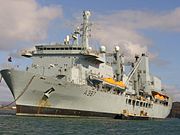
Sirius class stores ship USNS Spica
Combat stores ships, or Storeships were originally a designation given to captured ships in the Age of Sail and immediately afterward, used to stow supplies and other goods for naval purposes. Modern combat store ships are operated by the United States Navy and the Royal Navy. The Sirius and Mars classes (for the USA) and the Fort Rosalie and Fort Victoria classes (for the UK) provide supplies, including frozen, chilled and dry provisions, and propulsion and aviation fuel to combatant ships that are at sea for extended periods of time. In other navies, the term for the same type of ship is generally replenishment oiler, fleet replenisher, or fleet tanker and should not be confused with fast combat support ships or tenders.
Storeship[]

Both the United States and the United Kingdom used stores ships in the War of 1812. Again in the Mexican-American War in the Pacific and in the American Civil War captured enemy prizes that were not considered "warlike" enough to be sold for prize money often became stores ships for a naval force operating where no friendly ports are nearby. USS Fredonia took part in the Baja California Campaign in the Mexican-American War. In the Spanish-American War and the Filippino War the US Navy acquired the stores ship USS Celtic and other similar vessels to serve in its Asiatic Squadron.
Six combat stores ships operated by Military Sealift Command provide supplies, including frozen, chilled and dry provisions, and propulsion and aviation fuel to United States Navy combatant ships that are at sea for extended periods of time. Combat stores ships do not carry ammunition for resupply.
Combat stores ships provide underway replenishment of all types of supplies, ranging from repair parts to fresh food, clothing and mail via tensioned cargo rigs and CH-46 Sea Knight helicopters or their commercial equivalents. Combat stores ships are being replaced by more capable class such as the Lewis and Clark-class dry cargo ships in the US Navy.
Former combat stores ships[]

USS Celtic in the Spanish–American War in 1898
Three ships were transferred from the British Royal Fleet Auxiliary to MSC in 1981–83: USNS Sirius on January 18, 1981; USNS Spica on November 5, 1981 and USNS Saturn on December 13, 1983. Five Navy Mars-class combat stores ships were transferred to Military Sealift Command in 1992–94: USNS Concord on October 15, 1992; Mars on February 1, 1993; San Diego on August 11, 1993; San Jose on November 2, 1993 and Niagara Falls on September 23, 1994. San Diego was deactivated on December 10, 1997 and Mars was deactivated on February 12, 1998. Sirius was sold in 2005, Spica was used as a target ship and sunk in 2009 and Saturn was used as a target ship and sunk in 2010.
References[]
| ||||||||||||||||||||||||||||||||||||||
The original article can be found at Combat stores ship and the edit history here.